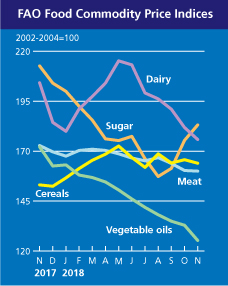Globally traded food commodity prices declined in November, led by marked drops for palm oil and other vegetable oils.
The FAO Meat Price Index averaged 160 points in November, marginally lower than its slightly revised value for October, and 7.4 percent below its level in the corresponding month last year. In November, international price quotations for poultry, pig and ovine meat continued to ease, with ovine meat falling the most, while those of bovine meat marginally recovered. Notwithstanding increased demand from Asia, ovine prices declined, underpinned by high export supplies from Oceania. Pigmeat price quotations fell for the third consecutive month, reflecting availability of large export supplies from main producing regions and continued trade restrictions imposed on account of African swine fever outbreaks. Poultry meat prices remained under pressure due to slack demand. By contrast, after five months of declines, bovine meat prices rebounded slightly, supported by somewhat limited spot supplies and firm demand from Asian markets.


The FAO Food Price Index averaged 160.8 points for the month of November, down 1.3 percent from October and 8.5 percent from a year earlier. The index, an indicator of the monthly change in international prices of a basket of food commodities, is now at its lowest level since May 2016.
The FAO Vegetable Oil Price Index hit a 12-year low, declining 5.7 percent from October. Large palm oil inventories and abundant supplies of soy and sunflower oils fueled the decline.
The FAO Cereal Price Index, covering wheat, coarse grains and rice, dropped 1.1 percent during the month, reflecting large export supplies of wheat, intensified export competition for maize and new crop arrivals of rice.
The FAO Dairy Price Index declined for the sixth consecutive month, falling 3.3 percent from October, as large stocks and increased availability of export supplies - especially from New Zealand - led to lower price quotations for butter, cheese and whole milk powder.
The FAO Sugar Price Index defied the downward trend, rising 4.4 percent in the month. The increase was mostly due to a significant production decrease expected in Brazil, which has also lowered the share of sugarcane used to produce sugar to 35.8 percent from almost half a year ago.
Thursday December 6, 2018/ FAO.
http://www.fao.org




